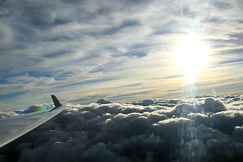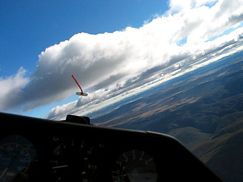Questions that are often asked about gliding
- Is gliding safe?
- How much will it cost?
- How long will my flight last?
- What happens when the wind stops?
- How does the glider get into the air?
- How do gliders stay up?
- How fast can a glider fly?
- How high can a glider fly?
- How far can a glider fly?
- What happens when the lift stops?
- How long can you stay up?
- How old must I be to fly?
- How long will it take to go solo?
- Can I do aerobatics?
- Do I need a license ?
While any form of aviation carries an element of risk, gliding is relatively
safe. Gliders are very strongly built, and there is no engine to fail. In
the unlikely event of an accident occurring, there is no fuel to burn.
Significantly, the Canberra Gliding Club has been operating in the region
for more that 40 years and has always returned pilots and passengers back to
the ground safely.
top...
See our page about Air Experience Flights for the costs of taking your first flight in a glider.
To learn to fly a glider, the costs are largely dependent upon the aptitude of
the student and how frequently you come flying - obviously if you are able to come to the
airfield each weekend for a few consecutive weeks, you will learn faster than if you were
to come flying only one day a month.
An average student will be ready for their first solo flight after
approximately 20 to 40 flights at a cost of between $1000 to $2000.
top...
Gliding is a weather dependent sport. In the absence of thermals, which
gliders use to stay in the air, an average flight to 2500ft will last
approximately 20 minutes. When learning to fly, you will be taught how to find
& stay in thermals, and a thermalling flight is much longer.
top...
What happens when the wind stops?
Nothing! Gliders are not dependent upon the wind to stay aloft. When
circling in thermals, gliders are drifted along by the wind, but otherwise are
unaffected by the wind.
top...
How does the glider get into the air ?
Our gliders are launched by aerotow using our high powered Piper Pawnee
tugs. The glider is attached to the tug by a rope, and the glider pilot follows
the tug as he is pulled up to the release height, when the glider pilot
releases the rope.
top...
Gliders can stay aloft by a number of means. By far the most common is
called thermalling. When the ground is heated by the sun, periodically a parcel
of heated air ascends, often to many thousands of feet, as the temperature of
the air close to the ground becomes higher that its surroundings. If a glider
is flown to stay in that column of rising air, by circling, the glider will
also be swept aloft.After the pilot reaches the top of the thermal, he flies
off, gradually losing height, until he reaches the next one.
top...
Gliders can fly as slowly as 35 knots (65kmh) to approx 135 knots (250kmh)
top...
Thermals can go as high as 14,000 ft or more. The new world glider altitude record
set by Steve Fossett and Enevoldson in Argentina is 50,671 feet (15,447 m). In fact the Australian gliding height record was
achieved in a flight from our site and stands at some 33,000 feet.
top...
In the summer, flights of hundreds of kilometers are commonplace. The world
record for a flight in a straight line is 2000 kilometers.
top...
What happens when the lift stops?
When the thermals stop working, the glider will gradually descend. A glider
can fly about 10 km for each 1000 feet of height, so there is a good chance
that an airfield will be within reach. In the event of no airfield being within
reach, the glider will land in a paddock. Paddock landings are part of the
training of every glider pilot once they are ready to fly cross country. The
glider can be retrieved by a tug, or, of this is not possible, the glider is
disassembled and returned to the airfield in its container.
top...
Gliders can remain flying as long as there is lift available. Using
thermals, this is about 8 hours. By using prevailing winds blowing up a slope,
a glider can be flown for as long as the wind is blowing. The world record
stood at around 56 hours before it was recognised that these ever lengthening
flights were dangerous, and recognition for duration flights abolished.
top...
How old must I be to fly a glider ?
The lower age limit to fly solo is fifteen, and there is no upper limit provided you are healthy, and suffer no medical conditions that may impede your ability to fly. Many start gliding as a hobby when they retire.
To be a passenger in a glider you can be almost any age at all. Our Club recently flew
an 86 year old woman, and several Club members regularly take their children for flights.
For practical purposes, our Air Experience Flights are not recommended for children
under the age of 12 years, because they often can't see outside the aircraft, and if they
get upset for any reason it is difficult to calm them down again.
top...
How long will it take to go solo?
This largely depends upon your aptitude and the frequency of your flying. You could
typically expect to go solo after between 20 and 40 flights. People with some power flying
experience will generally take less time to learn than someone with no flying experience at
all.
top...
We would not normally perform aerobatics on the first Air Experience Flight, until we had time to assess your reaction to the flight. If one of our experienced instructors was satisfied there would be no problems, then aerobatics could be performed.
The gliders in our Club feel are all capable of various aerobatic maneouvers, such as
loops, spins, chandelles (like a wing-over) and stalls. Naturally, without an engine, and
with such large wingspans (15m to 17m), there is a limit to what sort of aerobatics gliders
are capable of.
top...
Unlike power flying or driving a car, there is no formal license issued to glider pilots.
Rather, each pilot keeps a log book which records their flying progress. When the instructor
feels that they're ready to go solo, their log book is endorsed. As they gain additional
experience and make conversions to the various single seater aircraft in the Club fleet, extra
endorsements are recorded in the log book.
top...


